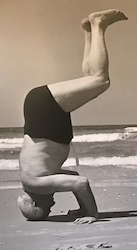
Have you a gap in your Self Image?
The Self Image is the core from which we move, act, think and even feel. Dr. Feldenkrais had an idea about the self-image being much broader than the social self-image that is in popular psychology — it is that with which we generate our thoughts and actions.
How would you know? You are probably unaware of your self-image being incomplete. However, you make mistakes, or you feel stiff and achey. These are examples that arise from an incomplete self-image.
To be clear, this Self Image is not just your conscious picture of yourself and the values and feelings related to it (which are, of course, important). This notion of “self-image” extends beyond conscious perceptions to encompass how your entire being orchestrates various actions, from the mundane to the intricate.
Think of a limitation you have — it is plausible that this hints at an aspect of your self-image that is incomplete — there is a gap, and this leads to your overall system compensating for the gap.
A student recently asked about a sharp pain in her shin that appeared irregularly, but was very briefly disabling. Here’s how I replied to her:
You might be contemplating the likelihood of a similar experience occurring again, understandably hoping to avoid it. Have you experimented with applying pressure to that spot again? If so, what have you observed? f you’re concerned about any underlying issues, I’d highly recommend consulting a trusted medical professional who possesses in-depth knowledge of the anatomy in question.
It’s important to clarify that the Feldenkrais Method isn’t geared toward diagnosis; rather, it is a process of inquiry with the focus of increasing wellness and overall functioning. My initial curiosity lies in inquiring if the issue might be linked to challenges in certain movements, such as walking, kneeling, or bending. Perhaps similar sensations arise when lying down, especially with blankets on your feet? Exploring the tonus (the degree of tightness) of muscles from the bottom of your feet to your lower back could provide valuable insights.
If you came to see me for a private session, with a concern about a pain in your shin, here’s how I would approach it. First we would sit, and you could give me any additional information. Then, in sitting, I might ask you to move in certain ways that might inform us some aspects that you might have missed. I probably would ask you to walk a bit, again so I can lean a bit more about how you allow weight transfer. Then I would invite you to lie on the Feldenkrais table, and we would add supports behind the head, the knees, and elsewhere so you are deeply comfortable, without strain. My exploration would be a non-verbal earning process as I would follow with my hands the sensation as I can sense of how that leg is organized — that is, how efficiently weight is transferred through the leg, even up to the head. I would compare the two legs and subtly invite options for improving to refine this process, thereby improving the implicit self-image, thereby educating the system a more effective way for weightbearing. As your system improves, you will feel an ease in breathing, a softening (“letting go”) in the abdomen, the neck and the face. When you sit and then stand, further changes will be apparent to you.
It’s plausible that this experience hints at an aspect of your self-image that is incomplete leading to your overall system compensating for the gap. Further exploration would follow a non-verbal process as this facet of self-image operates beyond conscious awareness. I would follow with my hands the sensation as I can sense of how that leg is organized — that is, how efficiently weight is transferred through the leg, even up to the head. I would compare the two legs and subtly invite options for improving to refine this process, thereby improving the implicit self-image, thereby educating the system a more effective way for weightbearing. As your system improves, you will feel an ease in breathing, a softening (“letting go”) in the abdomen, the neck and the face. When you sit and then stand, further changes will be apparent to you.
And, finally, I encourage you to consider Awareness Though Movement™ classes. These provide very unique ways to approach this hidden aspect of yourself, through movement and your ability to observe yourself. I have many courses online — even free ones — so check out the current classes (https://www.somaticjourneys.com/classes/) or prior recorded courses (https://feldenkrais247.com)
For further reading, come to:
- On Self-Image, by Fariya Doctor
- On the Self-Image, a lecture by Dr. Feldenkrais
And, of course, you can always write to me, rblack@somaticjourneys.com





